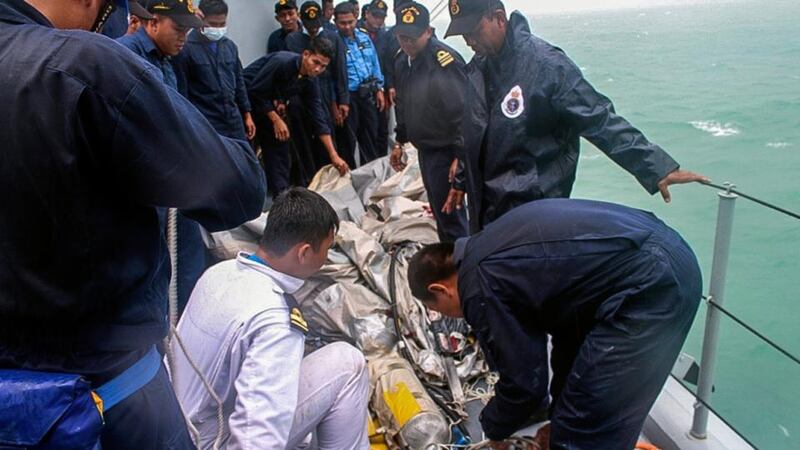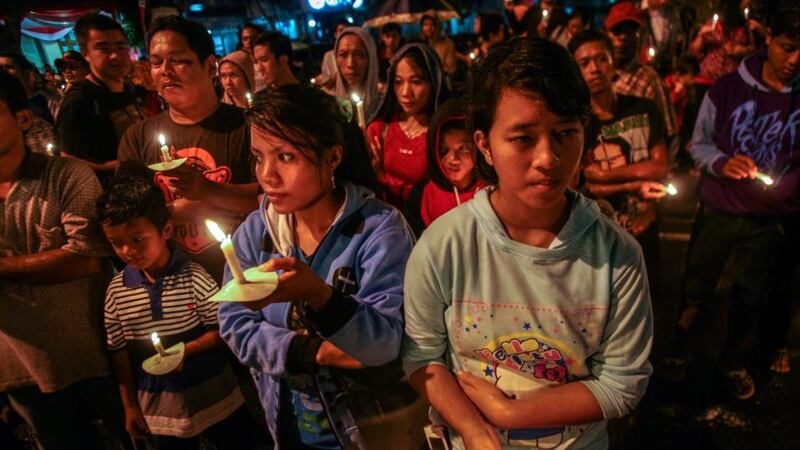The first two bodies from the AirAsia plane that crashed off the coast of Borneo have arrived in the Indonesian city of Surabaya, where relatives have gathered to await news of their loved ones.
Rescuers believe they have found the plane on the sea floor off Borneo, after sonar detected a large, dark object beneath waters near where debris and bodies were found on the surface.
Ships and planes had been scouring the Java Sea for Flight QZ8501 since Sunday, when it lost contact during bad weather about 40 minutes into its flight from Surabaya to Singapore.


Seven bodies have been recovered from the sea, some fully clothed, which could indicate the Airbus A320-200 was intact when it hit the water. That would support a theory that it suffered an aerodynamic stall.
Tatang Zaenudin, an official with Indonesia‘s search and rescue agency, said earlier that one of the bodies found had been wearing a life jacket.
But he later said no victim had been recovered with a life jacket on.
“We found a body at 8.20 am and a life jacket at 10.32 am so there was a time difference. This is the latest information we have,“ he said.
Coffins Arrive
Two bodies, in coffins bedecked with flowers and marked 001 and 002, arrived by an air force plane in Surabaya.
Most of the 162 people on board were Indonesians. No survivors have been found.
Hernanto, head of the search and rescue agency in Surabaya, said rescuers believed they had found the plane on the sea bed with a sonar scan in water 30-50m deep.
The black box flight data and cockpit voice recorder have yet to be found.
Authorities in Surabaya were making preparations to receive and identify bodies, including arranging 130 ambulances to take victims to a police hospital and collecting DNA from relatives.
Strong wind and waves hampered the search and with visibility at less than a kilometre, the air operation was called off in the afternoon.
“We are all standing by,“ Dwi Putranto, who headed the air force search effort in Pangkalan Bun on Borneo, said.
“If we want to evacuate bodies from the water, it‘s too difficult. The waves are huge and it‘s raining.“
Indonesian president Joko Widodo said his priority was retrieving the bodies.
Relatives, many of whom collapsed in grief when they saw the first grim television pictures confirming their fears on Tuesday, held prayers at a crisis centre at Surabaya airport.
Steep Climb
The plane was travelling at 32,000 feet and had asked to fly at 38,000 feet to avoid bad weather. When air traffic controllers granted permission for a rise to 34,000 feet a few minutes later, they received no response.
The pilots did not issue a distress signal.
A source close to the probe into what happened said that radar data appeared to show that AirAsia Flight QZ8501 made an “unbelievably“ steep climb before it crashed, possibly pushing it beyond the Airbus A320‘s limits.
“So far, the numbers taken by the radar are unbelievably high. This rate of climb is very high, too high. It appears to be beyond the performance envelope of the aircraft,“ he said.
The source, who declined to be named, added that more information was needed to come to a firm conclusion.
Three airline disasters involving Malaysian-affiliated carriers in less than a year have dented confidence in the country‘s aviation industry and spooked travellers.
Malaysia Airlines Flight MH370 went missing in March on a trip from Kuala Lumpur to Beijing with 239 passengers and crew and has not been found. On July 17, the same airline's Flight MH17 was shot down over Ukraine, killing all 298 people on board.
On board Flight QZ8501 were 155 Indonesians, three South Koreans, and one person each from Singapore, Malaysia and Britain. The co-pilot was French.
The AirAsia group, including affiliates in Thailand, the Philippines and India, had not suffered a crash since its Malaysian budget operations began in 2002.
Reuters












